Home Advertising At A Glance
by Gideon, HSM team writer
PlayStation Home, as a promotional tool, is ripe for the picking.
Unlike other platforms, which offer a limited amount of revenue options for developers to promote and extend the life of their game(s), developers who choose Home to support their work are able to utilize Home’s resources in just about any way they can imagine to engorge their customers in the world they painstakingly designed. By releasing content on Home, developers are able to offer a small taste of their game and give potential customers a glimpse of what they have to offer.
Not only can gamers be informed of upcoming releases, but through Home they are able to become familiar with the themes and overall style of the title before it is ever released. This can generate great interest in the game and can harvest fresh customers from the Home community, which may not have given the release a second glance. Many Home users are not what would be considered gamers. However, if they are in Home, chances are they are friends with gamers. This means there is potential to expand the audience of a video game beyond the fans of the series, and potentially create gamers out of surprised non-gamer Home players.
There is no shortage of options for developers within Home and there is no mandate as to how much – or how little – a developer must do to promote their game. This is the amazing thing about Home; the freedom which the developers are given to explore new avenues of advertisement and interaction for their customers is staggeringly vast. Currently there are posters, trailers, reward items, purchasable items, mini-games, public spaces and privates spaces which are available for utilization. Each offers their own benefits and each gives the gamer an extended reach into the gaming property which they are advertising. It is a veritable advertising playpen.
—
Home Posters/Billboards
These are the easiest, dirtiest and most traditional methods of getting information out to customers: print-type ads. Within Home, there are a number of spaces which offer ad space for developers to display witty and intriguing still ads and posters about their game. Once the Hub is released there will be five new spaces, which will likely have more focused advertising opportunities for games. This method used alone may not generate much more interest in the title, but used in conjunction with one or more of the other modes of advertisement, it can be a powerful tool for brand building.
Theatrical Releases
Just as posters and billboards, theatrical releases are among the most traditional methods of advertisements within Home. These pre-recorded videos are usually straight trailers for games, the likes of which can be seen around the web at any number of video game news sites. Some videos offer behind the scene glimpses of a video game or interviews, while others have offered tutorials and hints for their games. Theatrical ads can be utilized by game developers to generate interest in their game by providing content which might normally only be released on the video game’s own website. The difference being a video game’s website is a destination website, making its content isolated to those who are explicitly seeking out information about a particular video game.
With the Home Theatrical releases, there is the added benefit of being able to snag the attention of the passer-by. This possibility is compounded by 7PDB video screens which are not isolated to the Home Theater. Around Home, there are public video screens which can inform gamers. Many times these screens are used to advertise items and events within Home. By convincing a potential customer to take the small step into Home content, a developer can ease a customer into the notion of purchasing a full game. If a user is willing to go from seeing a public video to visiting a game space, then their interest has been piqued.
Avatar & Personal Space Items
Any item that can be obtained by a player and worn by their avatar would fit into the Avatar Item category. This ranges from full on costumes to simple t-shirts. These, by far, give a company the most exposure within Home. It turns every player who uses their items into a walking advertisement. When a user happens upon an outfit which they have not yet seen, many users will inquire as to where the new item can be acquired. By taking notice of a virtual item, a Home user becomes a potential customer who may not have been aware of the game before they saw the Home virtual item.
Personal Space items can still help with advertisement of a video game but, to be honest, are more fan-service for the Home community than they are effective advertising tools. The only way a person would see a Personal Space Item is if they were to obtain it themselves, or if they were to happen to visit a friend who just so happened to have it displayed in their personal space. While these can generate interest in a video game release, they are more effective at increasing the stream of revenue that can be siphoned from PlayStation Home than they are for advertisement.
There are multiple categories within the item category of Home content that can have different effects on the awareness of a video game release.
Home Reward
Home reward items are earned at no cost either within Home or in-game that are able to be used within PlayStation Home. These items can be the direct cause of sales of the video games, since there are many PlayStation users who will purchase and play disk-based video games solely on the fact that they can get Home rewards for their avatar. Rewards which are spread throughout a game will ensure users play the game at length to obtain all the Home rewards available. This could very well lead to a player becoming a fan of a series they wouldn’t have experienced if it weren’t for the offering of Home rewards. The in-Home earnable rewards offer developers a way to advertise their game to the Home public while enabling them to create a connection between their game and its players. This increases the interest in the title which the reward is for, and can lead to increased sales of said video game.
In-Game Reward
In-Game Reward items are items which can be awarded to a user from within Home that are useable within the disk-based game they are advertising. This is an extremely valuable advertising tool for developers. A Home user which is awarded an item for use within a game is much more likely to purchase the game than a Home user that is given a Home Reward item. Once the item is won, the player will become curious about the game and will want to see their reward in action. This is especially true if the reward item is exclusive to PlayStation Home. There is no greater game-bait than a system-exclusive feature.
Purchasable Items
Purchasable Items are a sticky situation for developers. While it is true that purchasable can provide the same advertising opportunities that free reward items can, it limits the exposure of the items. In most cases, it seems a lackluster free item will be sought after by more users than an interesting purchasable item. By making an item purchasable, a developer is limiting the audience to those who are already fans of the game. The benefit of purchasable items is increased Home revenue for the developer, and adding to the bottom line is always a good decision. So while the end results for the Home user may be the same for a purchasable item and a reward item, it is important for developers to decide which they are after, revenue or advertisement. In many cases, a well-known and highly anticipated game is more likely to offer purchasable items than a game which is seeking to add customers to its sales charts.
Pre-Order Bonus Items
These are devilishly devious and admittedly ingenious. Pre-Order Bonus Items are those which are offered only to Home users and are offered only at the time of pre-order for the game. This helps a developer on many fronts. First and foremost, it increases day one sales for the game. Just as Home rewards, there will be Home users who decide to purchase the game solely based on the in-Home rewards that are offered. However, unlike the Home Rewards, 5RNR Pre-Order Bonus Items have the added benefit for developers of ensuring that Home players who wish to own the limited item will purchase the game at full retail and not wait for its price to fall so they can snag up the Home Rewards on the cheap.
This leads directly into the other benefit of Pre-Order Bonus items, which is the increase of new game sales. By offering these items, developers are also ensuring that many more gamers will purchase their game new and won’t wait for it to hit the bargain bin at their local video game store. The Pre-Order Bonus Item is quite possibly the Home item which offers the greatest benefit for developers and the greatest pride for Home users. Most people get a great deal of satisfaction telling an admirer of an item they are wearing that it is no longer available, adding to the allure of the Pre-Order Bonus Item.
Public Spaces
Whether they are Limited Release or Permanent, Public spaces can be an invaluable tool for developers to advertise their game to the gaming masses. It is almost guaranteed that every regular Home user will visit whatever new space is released within PlayStation Home. The community is ready, eager and willing to inhabit whatever is developed. While at the new space, users will gladly watch videos, play mini-games, browse shops and learn about the game which is being advertised. This is a more direct and interactive advertising experience than any other medium can offer, and it’s only available on PlayStation Home.
Limited Release spaces are part of the Total Game Integration initiative by Sony, which allows an advertiser to take over a core space of Home for a limited amount of time to advertise their game and will ensure all of Home experiences their game and is aware of the title’s release. This can be used to fuel the ever powerful hype machine for the game and will no-doubt attract many who will spend additional time in the space just because it is a Limited Release space. The downside of a Limited Release space is inherent to its nature. It goes away. After the space is gone, the advertising power of that game greatly diminishes. At this point the developer will be relying on the success of their Limited Release space to convince users to purchase the full game. This will be accomplished through players wearing the Home Reward Items they won or through those who wish to continue the game’s experience, which began in Home.
Permanent Public spaces are best used to establish and feed a fan community within Home. They can exhibit the exact same features as a Limited Release space, but will be accessible to Home users for the length of whatever contract they worked out with Sony. While these spaces can serve as advertisements for a game, they are destination points within Home and must be deliberately navigated to. By founding a Permanent Public space a game developer is, whether they intend to or not, attaching themselves to the Home community. This can be extremely beneficial, but can also prove to be counterproductive in the long run. Many users are passionate about Home and if a permanent game space is underdeveloped or riddled with bugs, as spaces sometimes tend to get over the course of time, the developer could be negatively advertising the culture of their studio, which will turn away potential customers within Home.
Private Spaces
While Private Spaces share some of the difficulties of Permanent Public spaces, they provide one invaluable service to the advertising developer; they pull the Home user into the experience of the game. A private space, which is modeled after a game, allows a user to own a part of the games narrative while making them part of the narrative themselves. By seeing their avatar in and decorating their very own slice of whichever video game, players will no doubt envision what it would be like to be within the game. The user will then -to an extent – form an attachment to the game that could expand sales of the title. While it is true that there have been a few Private Spaces offered for free, it is a sure bet that a Personal space which is released in Home will yield a greater per-unit direct return than almost any Reward or Purchased item. This often overlooked aspect of the PlayStation Home advertising assemblage can be invaluable to a developer if it is used correctly and in conjunction with the other advertising aspects of Home.
Mini-Games
Mini-Games are, in a way, the most diverse advertising tool for developers. By giving players mini-games, the developers are providing a Reward item delivery platform. By offering items through mini-games, the advertising agent is assuring that there will be a large number of Home players who will excitedly play through their mini-game. These mini-games can provide Home users something of more value than amusement, an experience. If developed correctly, mini-games can be a sort of demo not for the game itself, but for the themes and atmosphere of the game. Giving gamers a glimpse into an upcoming title will attach gamers to the game like no other way can. Place this mini-game in a Personal Space and a developer will not only secure a greater number of Personal Space sales, but will also reap the benefit of extremely potent word of mouth advertisements. Most Home players like little more than bringing a friend to their personal space to win an item from a mini-game in their space. At that point, a friendship has had an experience which is tied to the game. This creates a type of personal and emotional connection to the game that can be achieved with no other advertising medium available today.
—
Although these opportunities within Home are powerful advertising tools, they aren’t the only opportunities within Home to advertise or interact with an upcoming or preexisting video game. Home is an open platform which, as has been proven, is quite powerful and is not limited by the existing experiences which have already been created. Here are but a few conceptualizations which could be viable uses for Home interactivity with video games. Take note that the advertising tools of Home are for the primary benefit of the advertising party.
VIP spaces only available to game-purchasers.
Once before, a video game offered an exclusive space which could not be accessed without the playing of a disk-based game. The Batman Personal space led many Home players to purchase, rent or borrow Batman: Arkham Asylum, and it is quite surprising that there haven’t been more spaces offered in such a way. This feature does not, however, need to be limited to personal spaces. If there were a limited access public space which required the purchase of a video game, many Home players would purchase that game out of fandom or desire to be able to access the Home space. If this sort of feature required the user to have the specific game’s disk inside the PS3 itself when moving to the specific space, gamers would be more likely to purchase the game instead of simply renting or borrowing it.
Cross Game Connectivity
Currently the connection between games and Home is limited to the accrual of special items in one program for use in the other. The possibility for Home to function as side support for video games is far greater than this. Disk-based games could reward users, as they have in the past, with items and personal spaces, but these rewards could be used within Home based mini-games to synergistically improve the disk-based experience. Scavenger hunt or trading type games could yield inventory items, such as health packs or ammo within a disk-based game. A disk-based game with a card collecting dynamic could use Home to allow a player to earn additional cards for use within the game itself, as well as duel with other players outside of the disk-based game. Training mini-games could be created within Home to increase 6J2N stats for a level based game or to provide a temporary game enhancing boost. Almost any aspect of a video game could be supported with Home content and activity without alienating those who do not use Home.
Avatar Export
This is one feature which would greatly increase the reach and influence of PlayStation Home on the PlayStation 3. Avatar Export would be an option for users to copy their current avatar into other video games. This could include almost any game type. From sports games to fighting games to RPGs, there is no game genre which would be barred from this feature. The feature could be as simple as head and hair export to transpose an avatars likeness onto any number of game characters, or as complex as full body export to transport the entirety of the avatar into a game world. This feature would also encourage game developers to release more content into Home, so that users could dress their avatars in a way that compliments the title they will be playing.
While this feature would only be an export function, and would not include external access to the Home closet features, it would extend Home’s culture outside of its current constraints and into the meat of the PlayStation Universe. This would no doubt lead Home players to purchase titles which support avatar export, if only to have duels with other players.
DLC Home rewards
Currently Home rewards are limited to the initial release of video game titles. It is almost expected in today’s video game industry for a title to be granted additional support with Downloadable Content. DLC could also be an opportunity for Home expansions as well. Not only would DLC enabled Home content entice gamers to purchase the DLC, but it would also be an incentive to purchase the parent game, if the wanting Home user had not already done so. This continued support would extend the reach of Home and the games which support it.
Regular updates to public spaces.
Home public spaces are sometimes released with the expectation of future updates, only to be seemingly abandoned by its developer early in its life. The dynamics of the Home economy is a microcosmic replica of the games industry as a whole, and just as DLC has cultivated a great deal of additional revenue for developers, regular updates in Home can do the same. Releasing content once and forgetting about it will not utilize Homes capabilities to their fullest. Without regular updates, the financial take from PlayStation Home will be meager and short lived. There are many developers who appear to try to use Home for a one time gain, and this just does not coincide with the virtual world’s culture. The more a company releases into Home, the more it’s citizens will invest in their branding. To release a space, especially one with planned expansion, only to drop support will lead to the Home community to show little support for the developer.
Arcade Cabinet Based Games
This is another aspect which has been accomplished within Home before but has largely been ignored by the gaming advertising community. In closed beta the very first Home gamespace, Uncharted’s Sully’s bar, was released. This space featured then, and still does, an arcade game called Mercenary Madness. This Arcade Cabinet featured a small 8-bit style game, in which players of the closed beta could win exclusive apartment items. This and the Echochrome are the only two Arcade Cabinets which have ties to full game releases, which is surprising and disappointing.
The Arcade Cabinet potential for Home is largely untapped. The Arcade Cabinet can provide the involvement and reward-item delivery system of the mini-game, the ownership of a personal space item and the appeal of a reward item, while also having the capabilities of incorporating some of the proposed concepts within this article. A disk-based modern open-world sandbox game could unlock an Arcade Cabinet within Home. That Arcade Cabinet could host a game that yields ammunition and weaponry for use within the disk-based game. This is but one example of how the Arcade Cabinet could be used to enhance just about any title released.
—
One of the more interesting aspects of Home advertising is that it doesn’t even have to be limited to video games.
Movies, music, books, television, clothes, and much more can benefit from the advertising environment Home has to offer. While there have been a few non-game companies to take advantage of Home’s offerings, the overall activity of these companies is meager. Home players are people who are consumers of pop culture. They are eager to take their Home experience out into the real word and vice-versa. If a product has a tie within Home, they are very likely to consider picking it up.
While what has been accomplished thus far is impressive, advertising has not seen its fullest potential within Home. Home does offer a solid base for developers to build upon, but they must be creative and be willing to put adequate resources into their Home offerings. The advertising methods mentioned here are not the only possibilities within Home, and with a little creativity, advertisers can produce content that will blow Home users and the advertising industry away.
With an established community filled with gamers and non-gamers, a functional platform which to develop on and low development costs, Home is literally up for anything. To say the sky is the limit would be putting too tight a constraint on the number of options that are open for a willing and capable developer.


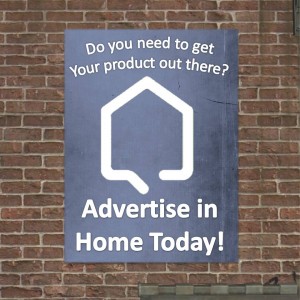
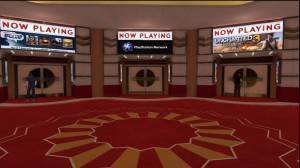
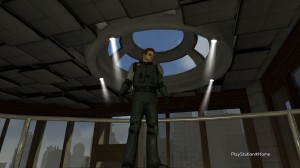
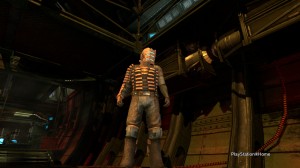
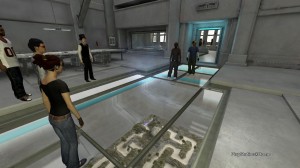
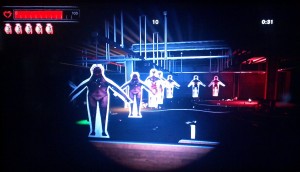


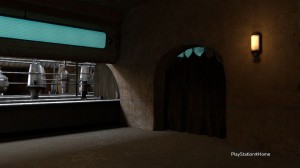
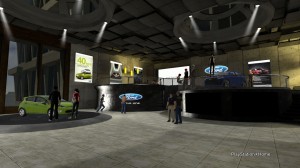
I’ve always stood by the idea that I’m not influenced by advertising unless it’s something I’m already interested in, however there’s always an element of subconcious bleed where (wether I like it or not) things I see are taken in regardless. So even the humble poster ad can still have an impact.
I remember when advertising in games first started to make its way. When games such as Extreme-G and wipEout first appeared they had less than a handful of companies that were willing to go the distance for such a tiny market segment, people like Storm (watches) Diesel (clothes) or even The Ministary of Sound (music record label) were “cool” enough to jump on board the new generation of Playstation consumers back in the 90’s.
Home has taken this ethos so much further though, and one of my fears as I became a comfortable resident of Home was the ammount of ads that were springing up. I’m not saying it shouldn’t be allowed, more rather the way they present the advertising should be done with creative thinking. This is indeed happening, I myself like putting Nate’s jeans from Uncharted onto my avatar and every time I do my brain tells me who those jeans belong to. It’s a crafty way of infuencing the user, the question is, how far does it really penetrate? A good example of this comes from one of my trips to the Irem beach, where I found a guy weraring a Blue Toad Murder Files full-on toad suit, yet everyone around (including the guy) called it a frog, oblivious to which game (if any) it was linked to. So in the end I think any advertising can only influence an individual as far as their awareness of each product will allow.
Wonderful article Gideon. I believe the potential in Home is great as well for any developers to utilize. Unlike television advertising which is costly and the user can choose to either walk away from and/or turn off, Home has more of a captive audience. We are there to talk to friends and play the in -- Home games and therefore are more likely to be exposed to any and all advertising that shows up here.
I agree that the public spaces created by people need to be regularly updated as well, otherwise the initial investment is basically going to be lost as the users will move onto newer things quite quickly.
There was another thing that Rockstar did to promote RDR awhile ago. It was an actual contest between Xbox and PS3 users within their disk based game that earned the users in Home avatar costumes. We had to fill up a thermometer that was cleverly placed on their online homepage to win the costumes. This mot only made a lot of us play RDR like crazy, it also made the customer base happy because we won something for everyone in Home.
This is an absolutely brilliant article.
To quote Nuff, “Said.”
I agree that this is a pretty informative article and covers alot of territory on this topic.I like that at the end after giving up all those ideas Gideon makes it clear that these ideas are just the beginning and there is certainly room for more.I think when the day comes when we say Home has enough in it and all the good ideas are installed will be the day that Home starts down the road to boredom,I hope that day is far,far off.Good stuff Gideon.